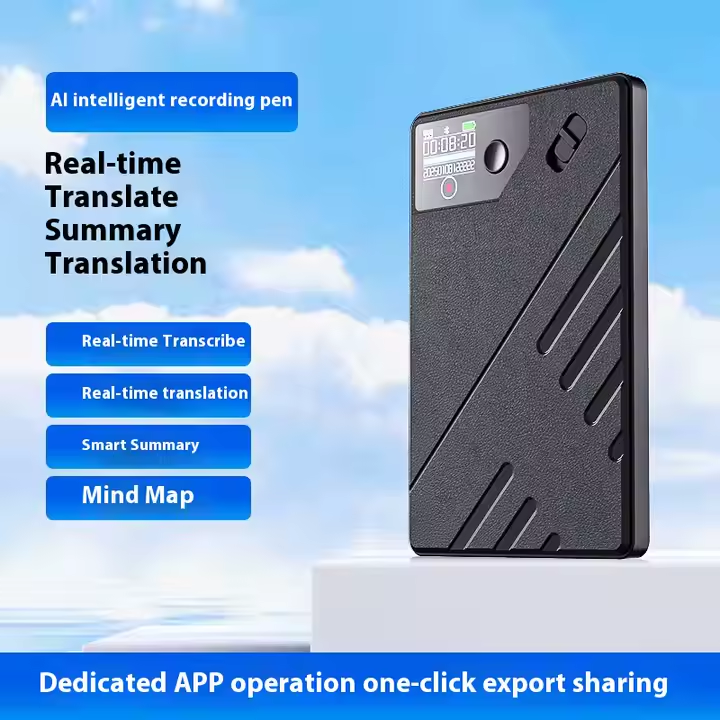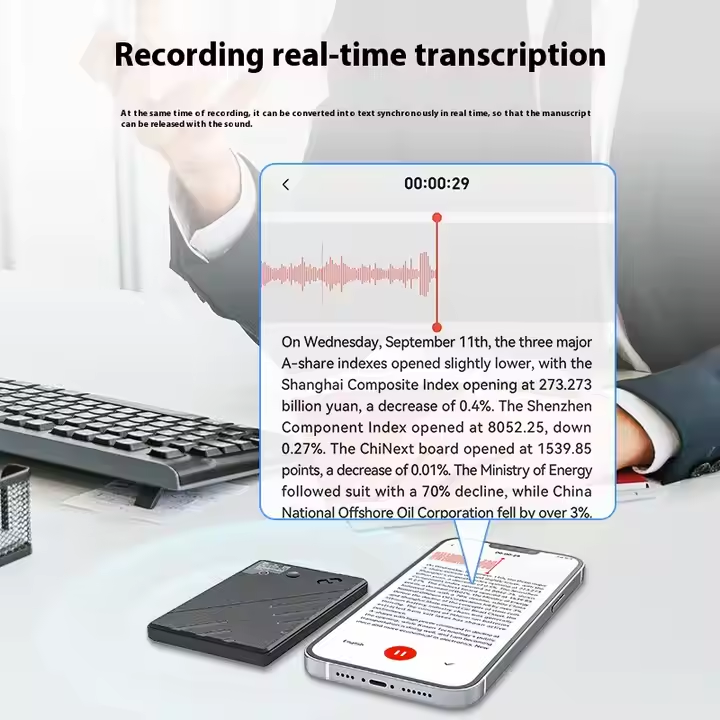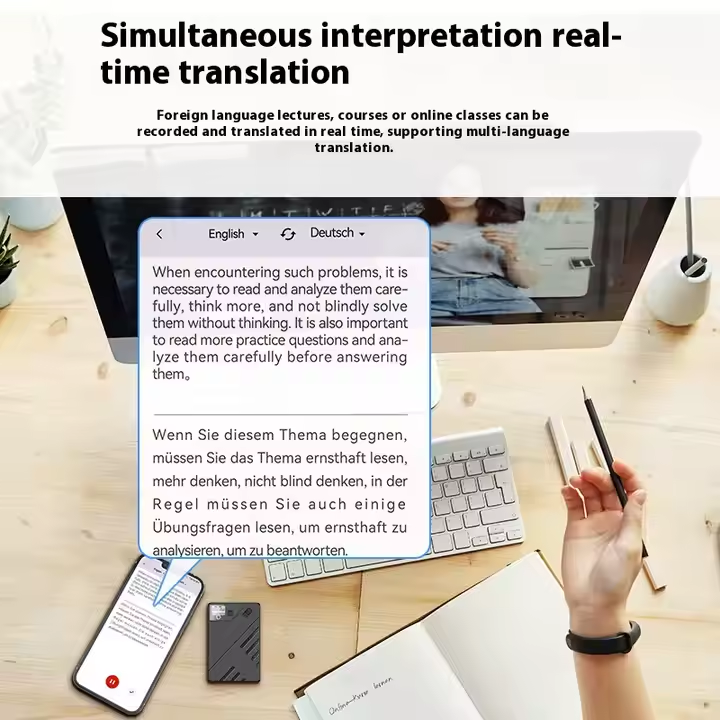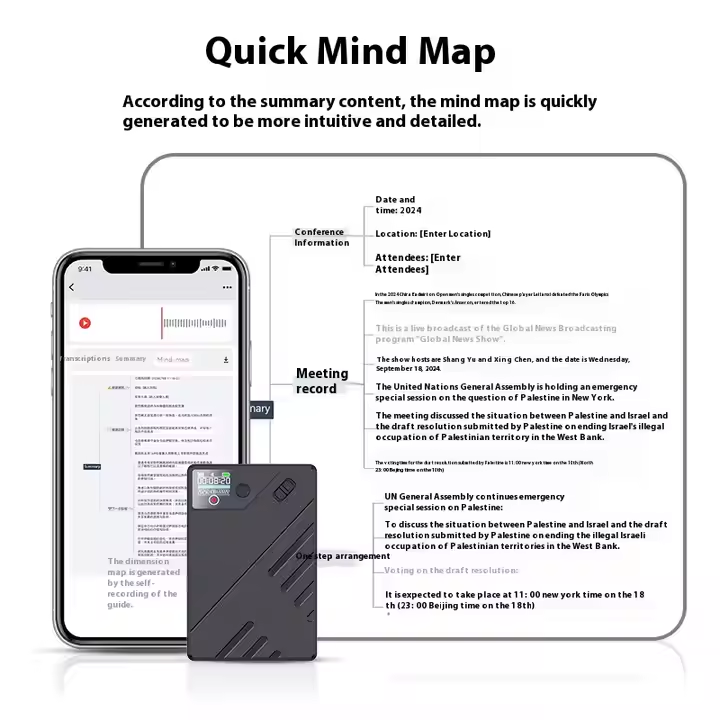
What Are the Key Features of AI Transcription Devices
Share
AI transcription devices have transformed the way we convert sound into text. These devices utilize advanced programs to operate quickly and accurately. They are particularly beneficial in sectors such as healthcare, media, and law. For example, the transcription market was valued at $21.01 billion in 2022 and is projected to grow by 6.1% annually, reaching $35.8 billion by 2032. These AI transcription devices come equipped with features like live speech-to-text and specialized settings for various tasks. They simplify processes such as taking meeting notes or transcribing calls. AI transcription devices provide high-quality, secure, and adaptable solutions tailored to your needs.
Key Takeaways
- AI transcription tools change speech into text fast and correctly. They are very useful in jobs like healthcare and law.
- Smart programs make them work well, even with background noise. They can handle different accents and tricky situations.
- They transcribe in real-time, saving time and effort. This helps users focus on work instead of writing notes by hand.
- Users can adjust settings to fit their job needs. This makes the transcription more accurate and helpful.
- Strong safety features, like encryption, keep data private. They also follow rules to protect sensitive information.
Accuracy in AI Transcription
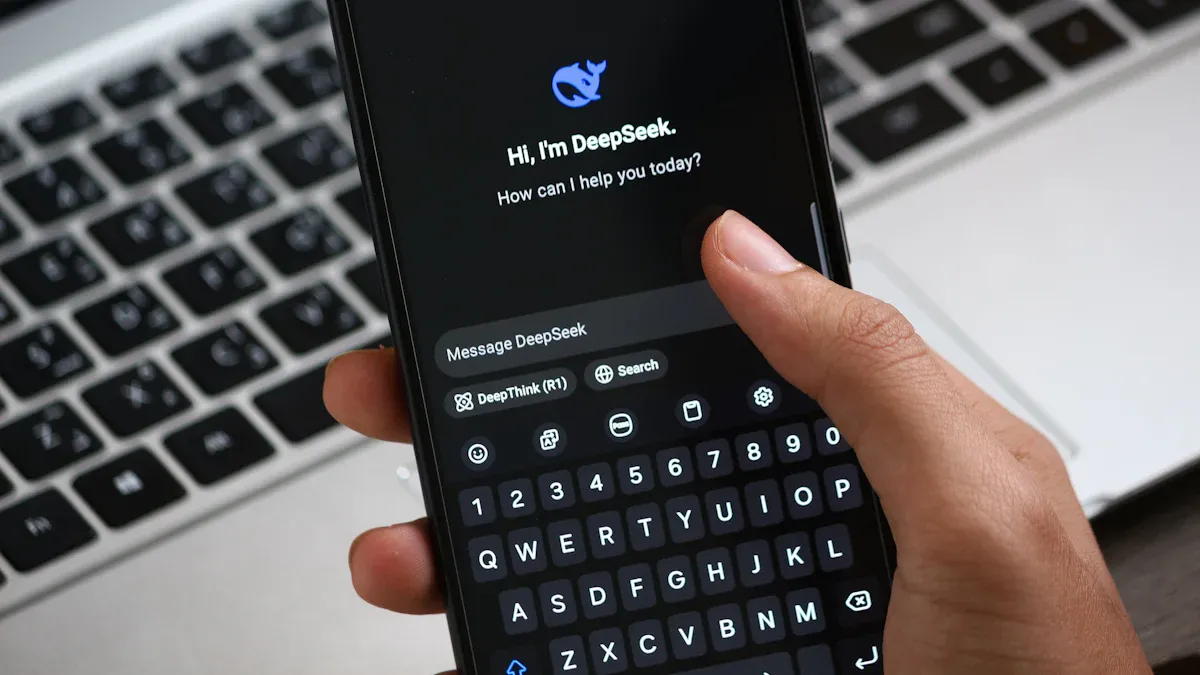
Advanced speech recognition algorithms
AI transcription tools use smart programs to create accurate text. These programs study sounds and turn them into words quickly. New technologies like Conformer-1 and Conformer-2 have improved this process. Conformer-1 works 29% faster and makes 43% fewer mistakes in noisy places. Conformer-2 is better at recognizing numbers and letters by 31.7%. It also handles background noise 12% better. These upgrades help make sure your transcriptions are correct, even in tough situations.
Handling diverse accents and background noise
AI transcription systems can understand different accents and block out noise. This is important for keeping text accurate in real-life situations. For example, they work well in meetings with people from various places or in noisy areas. New ASR technology has made these tools much better in loud settings. The quality of the training data helps the system handle tricky audio better. This ensures it works well with all kinds of sounds.
Importance of precision in professional settings
Getting accurate text is very important at work. Good transcripts keep the meaning clear and capture important details. In fields like healthcare and law, small mistakes can cause big problems. Accurate text also helps people with hearing issues by making things easier to understand. In schools, it helps students learn hard topics without confusion. By reducing mistakes, AI transcription tools make sure your text is clear and trustworthy.
Speed of AI-Powered Transcription
Real-time speech-to-text capabilities
AI transcription tools turn speech into text instantly. They capture conversations as they happen, giving you quick access to accurate text. Tools like Secure Speech can handle talks with many speakers without slowing down. This feature is helpful for live interviews or legal cases where fast documentation is needed.
Modern systems like Speechmatics process lots of audio every month. They understand different accents and dialects while keeping up with fast conversations. These tools also pull text from audio and video files quickly, making them perfect for jobs that need fast results.
Efficient processing of large audio files
AI transcription tools work fast with big audio files. Models like Whisper Large v3 can transcribe hours of recordings quickly. For files longer than 30 seconds, GPUs like the RTX 4080 transcribe 40 seconds of audio in just one second. This speed makes handling long recordings easy.
Affordable options like the RTX 3060 are great for businesses with lots of audio. It can transcribe nearly 200 hours of audio for just one dollar. Whether your recordings are short or long, AI tools process them quickly and accurately.
Enhancing productivity through rapid transcription
Fast transcription tools save time and boost productivity. Using AI tools means you don’t have to spend hours doing it manually. For example, transcribing one hour of audio by hand takes five hours. AI tools finish the same job in ten minutes, saving almost five hours.
The time saved grows when you work with more recordings. If you transcribe ten hours of audio a month, AI tools cut the time from 50 hours to just 100 minutes. This lets you focus on other tasks and get more done. By using AI transcription tools, you can work faster and achieve more in less time.
Customization Features in AI Transcription Devices
Industry-specific vocabulary adaptation
AI transcription tools are great at learning special terms. They understand words used in fields like healthcare, law, and media. For example, in healthcare, they can correctly write terms like "heart attack" or "angioplasty." This makes sure your text is accurate and fits the topic.
You can check how well these tools handle tricky words using performance measures. Important measures include bot accuracy, speed, word mistake rate (WER), and knowledge of specific terms. The table below explains these measures:
|
Metric |
Description |
|---|---|
|
Bot Accuracy |
Shows how well the tool understands and answers questions. High accuracy means better results. |
|
Latency |
Measures how fast the tool responds, which is key for smooth use. |
|
Word Error Rate (WER) |
Checks how many mistakes are in the text, showing its accuracy. |
|
Vocabulary and Domain Knowledge |
Tests how well the tool knows special terms for your field. |
By looking at these measures, you can see if the tool fits your needs.
User-defined preferences for personalized output
AI transcription tools let you change settings to match your style. You can pick options like naming speakers, adding timestamps, or choosing text formats. For example, if you often transcribe interviews, the tool can label speakers for you. This saves time and keeps your text clear.
You can also teach the tool to focus on certain words or phrases. This helps when working with unique topics or local accents. By setting it up your way, you get better control over the final text.
Benefits of tailored transcription settings
Custom settings offer many benefits. They make the text more accurate by focusing on the words you use most. This means less fixing later, saving time and effort. Custom settings also make work faster. For example, templates can help with tasks like meeting notes or legal papers.
Customizing also ensures your text meets your work standards. Whether you're in a busy newsroom or a detailed legal office, these tools adjust to your needs. This flexibility makes them useful for any job.
Integration with Other Tools

Compatibility with software and platforms
AI transcription tools work well with many programs. This makes managing tasks easier. They offer features like accurate text, topic analysis, and smart searches. For example, Veritone's iDEMS suite links transcription tools to different data sources. It automates tasks and improves analyzing digital evidence, including text conversion. You can organize and label messy data quickly. Whether using video editing apps or customer management tools, AI transcription works smoothly. It saves time and reduces effort.
API support for seamless workflows
APIs help AI transcription tools connect with other systems. This makes work faster and easier. Modern APIs are very accurate, even in tough situations. For example, clean audio gets 94.2% accuracy, while noisy audio gets 87.5%. Medical terms are transcribed with 91% accuracy, making them reliable for special jobs. Big-business APIs promise 99.95% uptime, so they rarely stop working.
APIs also offer tools like mood analysis, caller intent tracking, and custom goal monitoring. These features help you find useful information in transcription data. This improves decisions and makes work more efficient.
Use cases in business and professional environments
AI transcription tools help many businesses. PayPal uses them to spot fraud, keeping users safe. Salesforce uses them to predict sales and rank leads, improving marketing plans. Walmart uses transcription to improve supply chains, boosting efficiency by 30%. Amazon adds transcription to chatbots, making customer service faster. IBM uses transcription in healthcare to create personalized treatments.
These examples show how AI transcription makes work faster and better. Whether handling customer chats or studying big data, these tools adjust to your needs. They help businesses grow and work smarter.
Security in AI Transcription
Encryption and data protection
AI transcription tools keep your data safe with strong encryption. They protect information when it's stored or being sent. This stops anyone from reading it without permission. For example, AES-256 encryption keeps your data private and secure. Special key management ensures only trusted people can unlock the data.
When you use these tools, your recordings are turned into unreadable code. This keeps outsiders from seeing sensitive details. Industries like healthcare and finance rely on this protection. These measures make sure your data stays safe and private.
Compliance with privacy regulations
AI transcription tools follow strict privacy rules to protect your data. For example, HIPAA ensures health information stays secure in healthcare. The SOX law requires careful handling of financial records.
Companies offering these tools check for security problems often. These checks help them follow privacy laws and build trust. Workers handling private data get background checks and security training. These steps make sure your data is handled safely and responsibly.
Ensuring confidentiality in sensitive industries
Keeping information private is very important for AI transcription tools. This is especially true in fields like law, healthcare, and finance. These tools use strict rules to limit who can see the data. Extra protections, like physical and digital safeguards, add more security.
Some tools can also spot problems with privacy rules and create reports. This helps businesses stay private and follow the law. By using secure AI transcription tools, you can protect sensitive information and meet legal standards.
Scalability of AI Transcription Devices
Managing high transcription volumes
AI transcription devices handle lots of audio quickly and easily. They automate the process, saving you time and hard work. Instead of typing out hours of recordings, you can use fast tools to turn audio into text. This lets you spend more time studying the data instead of writing it down.
Tip: Automated transcription is great for studying phone calls. It helps find patterns and trends in conversations, making it easier to understand big sets of data.
Good transcription tools are key for managing many recordings. They work fast and stay accurate, even with tricky audio files. Using these tools makes your work smoother and helps you get more done.
Cloud-based solutions for flexibility
Cloud-based transcription tools are very flexible. They use smart programs and voice recognition to give accurate results. You can use them from anywhere, which is great for teams working remotely or in different places.
These tools also keep your data safe. They use encryption and special controls to protect private information. For example, healthcare workers can trust these tools to follow rules like HIPAA. Features like secure storage and activity logs help meet legal needs and keep data safe.
Note: Cloud-based tools cut down on mistakes and save time. This lets you focus on more important work.
Supporting growth in businesses and enterprises
Scalable transcription tools help businesses grow. The market for speech-to-text tools is growing fast, from $2.2 billion in 2021 to $5.4 billion by 2026. This shows how much people want voice-based tools and use smartphones more.
New ideas in transcription are helping this growth. Businesses save money and work faster with these tools. For example, legal offices organize case files better, and doctors create custom treatment plans.
Did you know? The marketing transcription market is set to grow from $5.74 billion in 2025 to $11.41 billion by 2034, showing how important AI transcription is becoming.
By using scalable transcription tools, you can stay ahead in business. These tools adjust to your needs and grow with your company.
AI transcription devices have changed how we turn speech into text. These tools are fast, accurate, and secure, making great transcripts. Using AI transcription saves time, cuts costs, and improves access for everyone. Whether you need to transcribe calls or take meeting notes, these tools adjust to your needs.
When picking an AI transcription tool, think about how it fits with other software, your budget, and how good the results are. These tools are changing industries like healthcare, law, and media. They handle big amounts of data, helping you work faster and smarter.
Tip: Look for AI transcription tools that let you customize and grow with your needs.
FAQ
What industries benefit the most from AI transcription devices?
AI transcription devices help fields like healthcare, law, media, and schools. They make tasks easier, like writing medical records or legal papers. These tools also help students by turning lectures into notes.
Can AI transcription tools handle multiple speakers?
Yes, many AI transcription tools can tell who is speaking. They label each speaker, which helps with meetings, interviews, or group talks. This keeps the transcript clear and easy to follow.
How do AI transcription devices ensure data security?
AI transcription devices keep your data safe with encryption. They follow rules like HIPAA and GDPR to protect private information. These steps make sure your data stays secure and confidential.
Are AI transcription tools suitable for small businesses?
Yes! AI transcription tools are affordable and grow with your needs. They save time by doing transcription automatically, which is great for small businesses with fewer resources.
Do AI transcription tools work offline?
Some AI transcription tools can work without the internet. This lets you transcribe audio anytime, even in places without Wi-Fi. It’s a handy feature for different situations.
Tip: Always check if the tool works offline before buying it.




